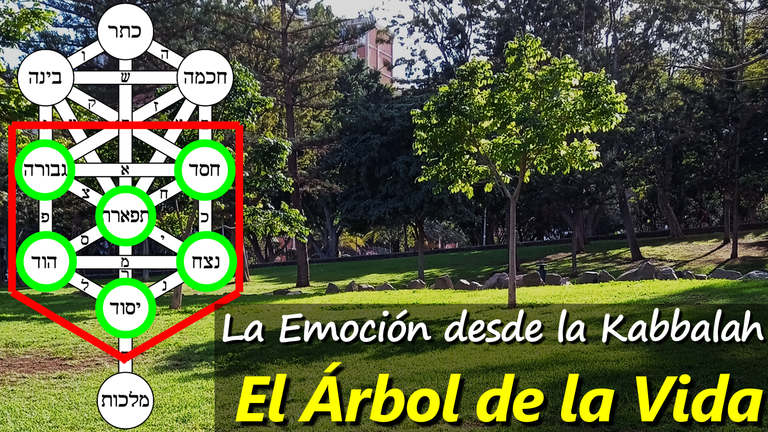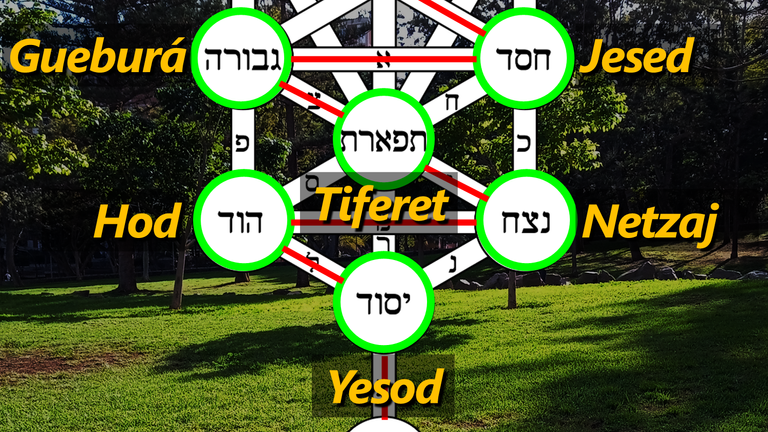Una Mirada a las Emociones desde la Kabbalah y el Árbol de la Vida🌳 [ESP-ENG]
¡Saludos! En este post les quiero hablar sobre un tema común pero visto desde una óptica poco común, o al menos no muy conocida por la mayoría. Las emociones y la Kabbalah, más específicamente desde al Árbol de la Vida, una herramienta o gráfico muy utilizado en la mística hebrea o judía.

La Kabbalah es parte de la mística judía, es decir, viene siendo un conocimiento o sabiduría que si bien es esotérico no tiene necesariamente relación con "ocultismo" ni cosas raras, sino más bien está dentro de lo que se consideraría un conocimiento que pretende elevar espiritualmente a las personas. Digo esto para aclarar un poco de que se trata el tema. Además, también es cierto que este post es sólo una interpretación personal y no una verdad absoluta sobre la Kabbalah. Dicho esto ¡Empecemos!
El Mundo de Formación
Así, en idioma español, y en hebreo "Yetzirá" ó "Olam Ha'Yetzirah" se llamaría lo que la Kabbalah llama o denomina a algo así como el mecanismo emocional del ser humano. Esto lo podemos ver más claramente en el Árbol de la Vida. Si quieres saber más de este árbol, te recomiendo visitar mi anterior post: Conozcamos el Árbol de la Vida: un diagrama del Alma Humana a la luz de la Biblia🌳📖.
En este árbol de la vida, compuesto por 10 "esferas" (sefirots: cada una representa un atributo en particular), las 6 esferas del medio son las que representarían este mundo de formación. Son 6 atributos representados en 6 cualidades o arquetipos humanos.
Lo que enseña la Kabbalah es que el ser humano construye su realidad según cómo se encuentre su emoción (formación). El desequilibrio de todas o algunas de estas sefirot genera que su realidad física refleje algún tipo de caos o desorden.
Darle Inteligencia a la Emoción
Sentir o tener emoción es algo muy humano, pero no está lejos de la esencia animal. Si bien a diferencia de los animales somos capaces de experimentar emociones complejas, las emociones, en conjunto con nuestro cuerpo físico y esencia animal o egoísta, suelen esclavizarnos. Más o menos de aqui surge la idea de la serpiente y Adán y Eva, pero ese es otro tema. La idea es que el ser humano se convierta en Rey sobre sus emociones, no al revés. Se trata de precipitar "inteligencia divina" a nuestras emociones.
Es por eso que cuando en la Biblia se narra la historia de cómo los hebreos descienden (en presente contínuo) a Egipto y luego son esclavizados por un faraón, la interpretación de la Kabbalah es que esto habla de cuando un ser humano nace (desciende su alma) e inmediatamente es esclavizado por sus limitaciones físicas y su esencia egoísta de únicamente recibir (y más adelante, por sus emociones).
Las emociones son como energía que sirve para crear cosas, pero depende de cómo esté nuestra fortaleza emocional, seremos capaces de crear o no, o de crear cosas que sean realmente positivas y no egoístas. Si miramos el Árbol de la Vida, la parte "emocional" o las 6 esferas centrales parecen ser una especie de "escudo", o en nuestro cuerpo se reflejaría en nuestro torso y pecho, es nuestro sostén (no ese sostén) y cómo se conecta nuestra mente con la tierra.
Si miramos las emociones como una forma o mecanismo de precipitar el "sustento divino" que emana de los "cielos", la emoción es un espacio intermedio entre el cielo y la tierra. Es como un mecanismo de corrección. Los "cielos" podría interpretarse tanto como las 3 sefirots de arriba como las mismas 6 sefirots centrales si lo miramos desde el punto de vista de la más inferior.

¿Y qué son estas 6 sefirots centrales?
Si bien podrían asociarse a algún patriarca bíblico, en el contexto emocional/espiritual se podrían definir como:
Jesed: Amor / Misericordia / Altruismo / Deseo de dar o influenciar positivamente (Abraham)
Gueburá: Fuerza / Rigor / Ponerse límites sanos / Restringir el dar (no se puede dar todo el tiempo) / Deseo egoista corregido (Isaac)
Tiferet: Equilibrio / Belleza / El Yo / El Amor propio / Dinánica de dar-recibir (Jacob)
Netzaj: Victoria / Perseverancia / Creatividad emocional / Lo Holístico (Moisés)
Hod: Humildad / Simpleza / El poder de las palabras (Aarón)
Yesod: Fundación / Conexión con el mundo material y con otras personas / Corrección del ego (Joseph)
Estas descripciones varían según las traducciones del hebreo y quien las interprete. Por último y para no hacer tan largo este post, según la Kabbalah, la Toráh (lo que vendria siendo los 5 libros del Pentateuco del Antiguo Testamento), es una representación o reflejo del mundo de formación humano. Es decir, cuenta historias bonitas y no tan bonitas, acerca de cómo el ser humano puede crecer espiritualmente y de qué sucede si no lo hace, metafóricamente, a través de desastres naturales y juicios que caen sobre los que no adquieren una madurez emocional.
Quizás estas emociones de las que habla la Kabbalah no son exactamente las mismas de las que se habla en términos cotidianos, sino más bien estados mentales o espirituales, pero no deja de ser una enseñanza o conocimiento que puede ser muy valioso sobre nuestras emociones.
¡Gracias por visitar mi blog! ¡Hasta la próxima!

Click here for the English Version
Greetings! In this post, I want to talk about a common topic seen from an uncommon point of view, or at least not well-known by most. Emotions and Kabbalah, more specifically from the Tree of Life, a tool widely used in Jewish mysticism.
Kabbalah is part of Jewish mysticism, that is, it is a knowledge or wisdom that although it is esoteric, is not necessarily related to "occultism" or weird things, but rather it is within what would be considered a knowledge that aims to elevate people spiritually. I say this to clarify a bit what the subject is about. Also, it is also true that this post is only a personal interpretation and not an absolute truth about Kabbalah. That being said, let's get started!

The World of Formation
So, in the English language, and in Hebrew "Yetzirá" or "Olam Ha'Yetzirah" would be called what the Kabbalah calls or denominates something like the emotional mechanism of the human being. We can see this more clearly in the Tree of Life. If you want to know more about this tree, I recommend you to visit my previous post: Let's know the Tree of Life: a diagram of the Human Soul in the light of the Bible🌳📖.
In this tree of life, composed of 10 "spheres" (sefirots: each one represents a particular attribute), the 6 middle spheres are the ones that would represent this world of formation. They are 6 attributes represented in 6 qualities or human archetypes.
What Kabbalah teaches is that the human being constructs his reality according to how his emotion (formation) is. The imbalance of all or some of these sefirot generates that his physical reality reflects some kind of chaos or disorder.
Giving Intelligence to Emotion
Feeling or having emotion is a very human thing, but it is not far from the animal essence. While unlike animals we are capable of experiencing complex emotions, emotions, in conjunction with our physical body and animal or selfish essence, often enslave us. This is more or less where the idea of the serpent and Adam and Eve comes from, but that is another topic. The idea is that the human being becomes King over his emotions, not the other way around. **It is about precipitating "divine intelligence" to our emotions.
That is why when the Bible tells the story of how the Hebrews descend (present continuous) to Egypt and then are enslaved by a Pharaoh, the Kabbalah interpretation is that this speaks of when a human being is born (his soul descends) and is immediately enslaved by his physical limitations and his selfish essence of only receiving (and later on, by his emotions).
Emotions are like energy that serves to create things, but depending on how our emotional strength is, we will be able to create or not, create things that are really positive and not selfish. If we look at the Tree of Life, the "emotional" part of the 6 central spheres seems to be a kind of "shield", or in our body, it would be reflected in our torso and chest, it is our brace (not that bra) and how our mind connects to the earth.
If we look at emotions as a way or mechanism of precipitating "divine sustenance" emanating from the "heavens", emotion is a middle ground between heaven and earth. It is like a corrective mechanism. The "heavens" could be interpreted as both the 3 sephiroth above and the same 6 central sephiroth if we look at it from the point of view of the lowest one.

And what are these 6 central sephiroth?
While they could be associated with some biblical patriarch, in the emotional/spiritual context they could be defined as:
Jesed: Love / Mercy / Altruism / Desire to give or positively influence (Abraham).
Gueburá: Strength / Rigor / Setting healthy limits / Restraining giving (you can't give all the time) / Corrected selfish desire (Isaac)
Tiferet: Balance / Beauty / Self / Self-love / Give-and-take dynamics (Jacob)
Netzach: Victory / Perseverance / Emotional Creativity / The Holistic (Moses)
Hod: Humility / Simplicity / The power of words (Aaron)
Yesod: Foundation / Connection with the material world and with other people / Correction of the ego (Joseph)
These descriptions vary according to the Hebrew translations and who interprets them. Finally, and not to make this post so long, according to the Kabbalah, the Torah (which would be the 5 books of the Pentateuch of the Old Testament), is a representation or reflection of the world of human formation. That is, it tells beautiful and not-so-beautiful stories, about how human beings can grow spiritually and what happens if they do not, metaphorically, through natural disasters and judgments that fall on those who do not acquire emotional maturity.
Perhaps these emotions that Kabbalah talks about are not exactly the same as the ones we talk about in everyday terms, but rather mental or spiritual states. However, it is still a teaching or knowledge that can be very valuable about our emotions.
Thanks for visiting my blog, see you next time!
Translated to English language with the help of DeepL.com
Fotografías de autoría propia / Own photos (Redmi 9C)
Otras redes sociales:
 |
 |
 |
F1 & motorsports: @acontmotor
Expresión Creativa. Literatura | Entretenimiento | Arte: @acontblog
| ¡Gracias por visitar! — ¡Thanks for visiting!  |
https://twitter.com/acontcivil/status/1766186877277663715
#POSH #X